7 Tricks and Tips to Cooking with Tea
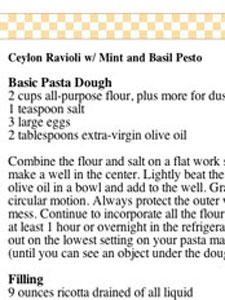
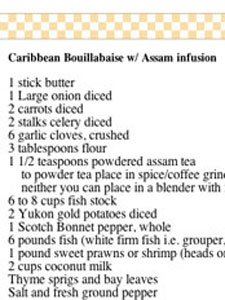
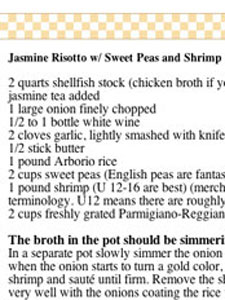
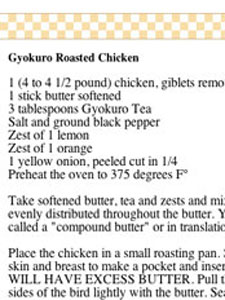
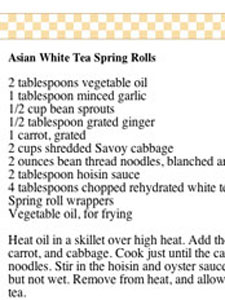
As a self-proclaimed chef and aficionado of all things culinary, I am always looking for new recipes, different flavors and fresh ideas. One night, while pondering the nightly question, "what's for dinner?" over a cup of tea, I was struck with inspiration. Looking into my steaming brew, I had a revolutionary idea: tea... in food. The more I contemplated, the more I began to wonder why this idea was such a long time coming. I love cooking and (obviously) I love tea... The marriage of the two seemed inevitable.
So I called up a chef friend (yes, an actual, genuine Culinary School grad), Gary Lamach II (co-owner and head chef of Atlantic City's famous LaSage Catering), and asked him if he has ever heard of such a combination. He told me, to my surprise, that tea is the newest trend in the Food Industry. Used in many gourmet restaurants, tea adds new and unique dimensions of flavor, texture and aroma to recipes that have become too hackneyed and overused. It seems that tea is not only "hot," but deliciously edible as well!
My eyes were open. The more I was told, the more I realized just how versatile Camellia Sinensis (the tea plant) could be. Here are just a few examples...
Tea as a spice: Simply grind tea leaves in a pepper mill (I personally recommend Oolong) and combine with white pepper. This makes an unbelievably delicious rub, perfect for a steak or a pork chop. The tea adds a wonderfully fresh Asian-cuisine nuance to this otherwise ordinary meal.
Tea as a marinade: Wondering what to do with that extra Earl Grey tea left in the teapot at the end of teatime? Don't dump it.... Use it! Try adding it to your favorite marinade for chicken breasts for an out-of-this-world addition that will be sure to have your guests wondering the source of the mysterious (yet familiar) flavor. As a vegetarian digression, tea marinated tofu is a wonderful substitution in this dish.
Tea as a tenderizer: Among tea's many benefits and effects, it is an efficient tenderizer. Want to get that falls-off-the-bone, melts-in-your-mouth effect for that dish that is great, but could be even better? Try adding some tea! Not to be camellia-exclusive, Rooibos "Red" tea has been shown to have similar results and may add yet another unique nuance for your culinary delights.
Tea as an oil: Because this is a non-discriminating newsletter, I must give voice to the fact that cooking with tea is not exclusive to tea leaves. Although it has been used for centuries throughout Asia, Tea Oil is only now making its way into Western Cuisine. Made from the seeds of the tea plant, this relatively neutral-tasting oil has shown to have a plethora of uses in itself. From a base to salad dressing to the perfect sauté oil (due to the very high flash point) and more, Tea Oil has become a popular substitute to more traditional vegetable and canola oils.
Tea as an aromatic: Although many chefs are nearly as hesitant as magicians to divulge their gastronomic tricks, Chef Lamach (whose cooking many have described as magical) revealed one of his cooking secrets. "In cooking," he says, "one has to pay close attention to the retro-nasal aromatics - the âflavor' you get in the cavity of your nasal passage. This is the true flavor that will always come through in your food and therefore must be complemented." Tea is the perfect complement to many flavors, filled with rich and subtle aromatics. Adding a touch of Jasmine tea to a rice dish will add many different interesting levels of smell and flavor that are sure to impress.
Tea as a dessert: It is a fairly common practice to take tea after a meal. But what about tea as the dessert? This trend is quickly building in popularity in the food industry and is revolutionizing the way we think about our after-dinner sweets. Most people have been introduced to Green Tea Sorbet, but what about Earl Grey Muffins or a Jasmine Ganache? Because many teas take sugar well, it is sensible to conclude that many sweets would take tea well. Many bakers and chocolatiers are adapting and adding new recipes to include the wonderful hints that tea can add.
Tea as a green: Finally, one must not overlook the simple fact that tea, like many greens used in cooking, is an edible leaf. For novice green tea drinkers, I have found quite often that they remark on the fact that it has a very "earthy, spinachy" taste. Why not use this taste to your advantage? Tomorrow morning, when making omelets, instead of using the usual spinach, try substituting Gyokuro leaves! This divergence from normalcy will surely receive great approval.
The benefits of cooking with tea seem almost as innumerable as drinking it. In many cases, when cooking with tea, it retains many of the essential vitamins and antioxidants as well as the HDL's (good cholesterols).
Tea, is seems, is not only a refreshing, delicious and healthy beverage, but also one of the most versatile and interesting ingredients that is (finally!) hitting the Western Culinary scene. I recommend that you consider using your favorite teas in your culinary exploration. Like many chefs say about cooking with wine ("Do not cook with a wine that you wouldn't drink"), for the best results, use the teas that best fit your tastes. You are limited only by your imagination in this journey for the search of new ways to take your tea. Happy and healthy travels!
As an endnote, I must give my great thanks to Chef Gary Lamach II, whose wonderful advice and information were immeasurable in the writing of this article. He was kind enough to take the time to create and donate several tea recipes which have been included in this article (all using Adagio Teas!), all of which are unbelievably delectable. I feel that is my obligation to the reader (rather than to him) to provide contact information on how to find out more about LaSage Catering. Please email Chef Lamach at chefdeuce@hotmail.com or call LaSage at (609) 804-9708... You'll be glad you did! Bon Apetit!
